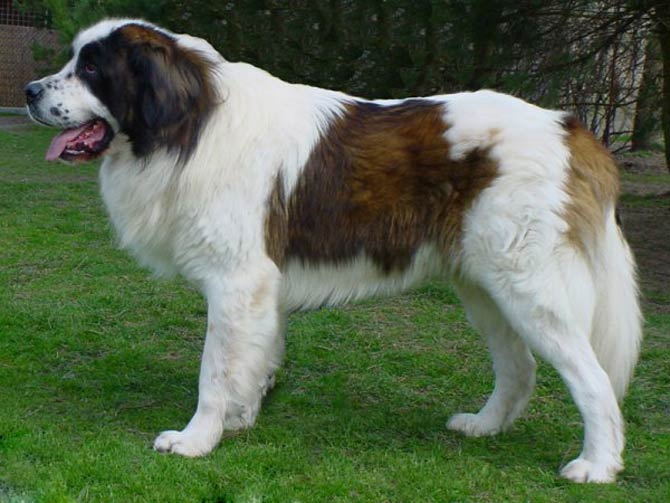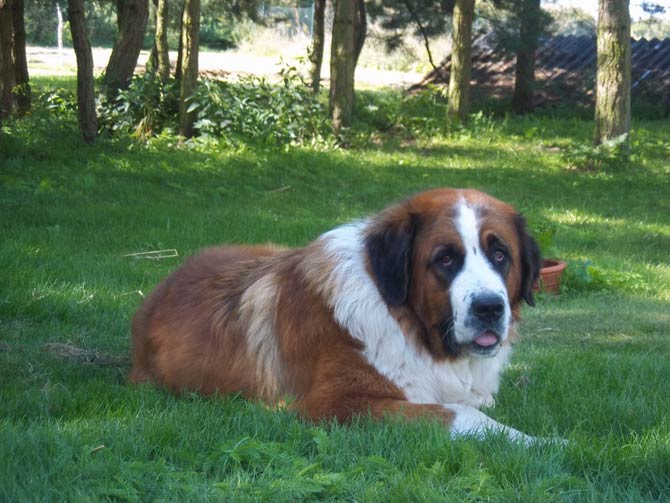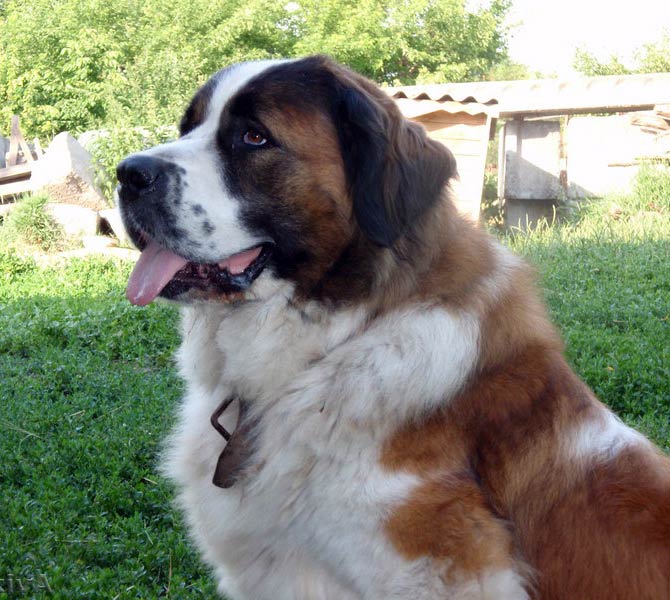Moscow Watchdog – Moskovskaya Storozhevaya Sobaka
Aggressive breed
A cross between two molossians – a Caucasian Shepherd Dog and St. Bernard Dog. It also has the genes of the Russian Harlequin Hound and the East-European Shepherd Dog. Is the Moscow Watchdog a gentle giant or an aggressive breed to which it is included?
Outside of Eastern Europe, the Moscow Watchdog is a little-known breed, although it appeared in the USA a few years ago. Perhaps the problem with low popularity lies in his disposition and destiny – the main task of these dogs was to guard state enterprises. The dog created for this function turned out to be not only a courageous protector, but also a wise human companion, requiring an intelligent and mentally strong guardian.
Despite numerous advantages, the Moscow Watchdog is classified as an aggressive breed. This fact may come as a surprise given that the dogs featured in this article are sometimes called gentle giants.

FCI Non-recognized breed
Conventional Classification
- FCI Group II: The Pinscher and Schnauzer – Molossoid and Swiss Mountain and Cattle dogs
- Section 2.2. Molossoid and Mountain dogs
- UTILITY ‑ guard dog, protective family dog, companion
- Other names: Moskovskaya Storozhevaya Sobaka, Московская сторожевая
The issue of the classification of this breed in the FCI is not yet obvious. The Russian breed club is working with the FCI to obtain official recognition of the Moscow Watchdog as a separate breed. Currently, he is recognized by the FCI as part of group 2, i.e. molossians. It can also take part in shows known as the Special Show. In Russia, however – the country of origin – these dogs are common at various shows.

History of the breed
The Moscow Watchdog was created by Russian breeders who wanted to develop a breed that was large, tough, with a strong guardian instinct, which, however, was to be obedient and cooperative with humans. Work on creating a new, specialized dog breed began in 1946, under the supervision of General Medvedev, active in the USSR Ministry of Defense. The new breed was supposed to guard not only households, but most of all places belonging to the state, such as railroads, warehouses, labor camps, etc.
After World War II, breeders began crossing Caucasian Shepherds with St. Bernard dogs, to achieve their goal. From the former, the new breed was to inherit caution and ruthlessness towards its attackers, and from the latter, it received in its genes great size and strength combined with a mild temper. As it turned out, this kind of crossword puzzle turned out to be a bull’s eye. The Russians acquired guard dogs, effectively protecting against criminals, which were abundant at that time. It also turned out that the Moscow Watchdog performs very well in the harsh Russian climate.
The first breed standard was published in 1985, when it received official status in its country. In 1986, several representatives of the breed were brought to Hungary so that breeders could popularize it. Today there are about 500 Moscow Watchdogs in Hungary.

Characteristic
Appearance
It is one of the largest breeds of dogs, its minimum height at the withers is 66-68 cm (26 – 27 in), and its weight is usually between 45-68 kg (99 – 150 lb). Despite its large size and weight, it is not clumsy or heavy.
It is characterized by muscularity, a massive head and powerfully built limbs. The hair is of moderate length and is thick, white and red. The tail is very fluffy and long – it can reach the ground. The overall appearance of the dog gives the impression of being resolute, smart, self-confident, but also inspiring confidence.

Temperament
It shows its strength not only physically but also mentally. However, it can be a good companion dog with a guardian instinct if it is properly socialized and raised, and has the right conditions for self-development. In the case of a Moscow Watchdog, space is very important – a dog requires a large yard, as well as frequent and long walks. Therefore, it is not suitable for living in a block of flats or tenement house.
Training
During the training, the dog should notice the herd leaders in its owners. His natural instinct is to lead his group. In the case of a large and mentally strong dog, and this is what the hero of this article is, a person must set clearly defined boundaries and make all decisions. The dog cannot feel that it has any power over the owner.
With firmness, consistency and calmness, we will win the respect of our ward, who will become a devoted and loyal companion. A well-mannered Moscow Watchdog will also be a prudent defender of his family when faced with a real threat.

Health condition
Due to its size, it may suffer from hip dysplasia, which is a problem for many large dogs. The Moscow Watchdog also needs plenty of room to move around freely, as well as regular physical activity such as long walks and jogging. In such activities, however, it is required that the animal walks alongside or behind its owner. This will prevent the dog from feeling like the alpha male leading the group.
Thanks to regular physical activity, your dog will stay fit and healthy for many years.

Detailed data / dimensions (size)
Moscow Watchdog
- Height at the withers:
- males: 68-78 (27 – 31 in)
- females: 66-74 cm (26 – 29 in)
- Weight:
- males: 55-68 kg (121 – 150 lb)
- females: over 45 kg (over 99 lb)
- Lifespan: 9-11 years

Moscow Watchdog – interesting facts
- The Moscow Watchdog is not very well known outside of Eastern Europe, where he is quite popular.
- Despite its strong character, the Moscow Watchdog can be trained as a guide dog for the blind.
- In many countries, the Moscow Watchdog is included in the list of dog breeds recognized as aggressive.



















